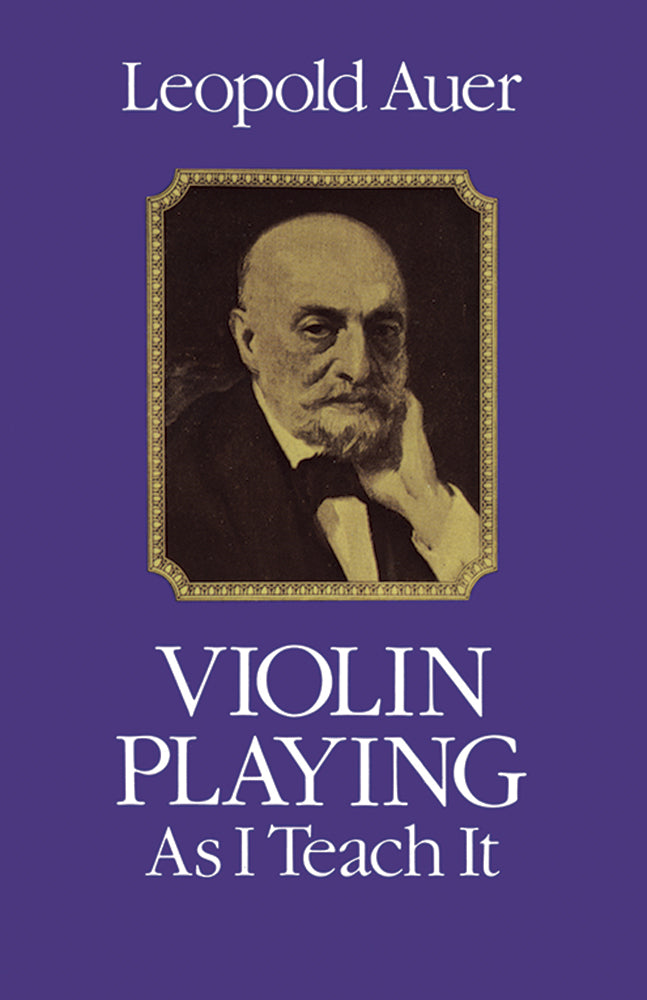
Dover Publications - 486
Auer Violin Playing As I Teach It
Publisher: Dover Publications
Binding: Paperback
Dimensions: 5.38 in x 8.5 in
Pages: 128
Quantity:
Pickup available at Juilliard Store
Usually ready in 4 hours
Auer Violin Playing As I Teach It
Juilliard Store
Pickup available, usually ready in 4 hours
144 West 66th Street
New York NY 10023
United States
Choose options
Quantity:
Pickup available at Juilliard Store
Usually ready in 4 hours
Auer Violin Playing As I Teach It
Juilliard Store
Pickup available, usually ready in 4 hours
144 West 66th Street
New York NY 10023
United States
Quantity:
Pickup available at Juilliard Store
Usually ready in 4 hours
Auer Violin Playing As I Teach It
Juilliard Store
Pickup available, usually ready in 4 hours
144 West 66th Street
New York NY 10023
United States
Leopold Auer (1845–1930) belonged to that select company of violin virtuosos who not only established the level of artistic excellence for the nineteenth century, but also trained many of the violinists who surpassed that level in the twentieth. Mischa Elman, Jascha Heifetz, and Efrem Zimbalist (Sr.) were among Auer's students. Himself a pupil of the great Joseph Joachim, Auer will always be regarded as one of the most important violin pedagogues in history.
This exemplary collection of principles and guidelines was set down by the master after a lifetime of playing and teaching. Auer taught by example, and he directs violin teachers to inculcate the intricacies of execution by means of the violin itself, not simply by verbal instruction. He then devotes the rest of his advice to the violin pupil: how to hold the violin and bow, how to practice, and how to approach such matters of technique as tone production, vibrato, bowing methods including the legato, left-handed technique, double stops, trills, pizzicato, harmonics, and phrasing. In the concluding chapters Auer takes up the more general topics of style, stage fright, changes in the violin repertory, and, of great historical interest, his practical repertory hints ― what he gave his own students to play. Many of the book's chapters are illuminated by biographical details and anecdotes about famous musicians whom Auer knew: Davidov, Wieniawski, Seidel, Wilhemj, Sarasate, and von Bulow.
Receiving poor direction at an early age is disastrous for a violinist. As Auer says, "There is no instrument whose absolute mastery at a later period presupposes such meticulous care and exactitude in the initial stages of study as does the violin." With this book every beginning violin student will have the benefit of the finest guidance.
This exemplary collection of principles and guidelines was set down by the master after a lifetime of playing and teaching. Auer taught by example, and he directs violin teachers to inculcate the intricacies of execution by means of the violin itself, not simply by verbal instruction. He then devotes the rest of his advice to the violin pupil: how to hold the violin and bow, how to practice, and how to approach such matters of technique as tone production, vibrato, bowing methods including the legato, left-handed technique, double stops, trills, pizzicato, harmonics, and phrasing. In the concluding chapters Auer takes up the more general topics of style, stage fright, changes in the violin repertory, and, of great historical interest, his practical repertory hints ― what he gave his own students to play. Many of the book's chapters are illuminated by biographical details and anecdotes about famous musicians whom Auer knew: Davidov, Wieniawski, Seidel, Wilhemj, Sarasate, and von Bulow.
Receiving poor direction at an early age is disastrous for a violinist. As Auer says, "There is no instrument whose absolute mastery at a later period presupposes such meticulous care and exactitude in the initial stages of study as does the violin." With this book every beginning violin student will have the benefit of the finest guidance.
Reprint of the Lippincott, 1960 edition.
